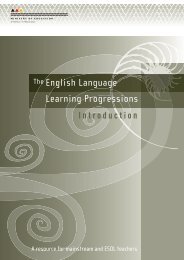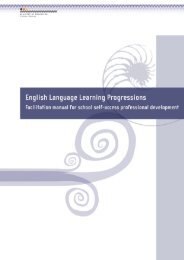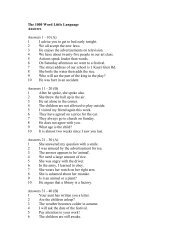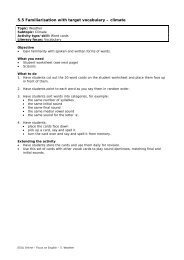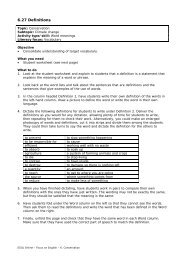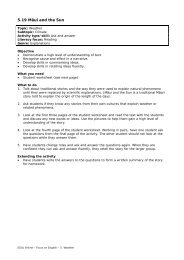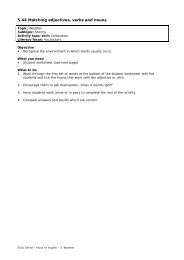ELLP Years1-4 - ESOL - Literacy Online - Te Kete Ipurangi
ELLP Years1-4 - ESOL - Literacy Online - Te Kete Ipurangi
ELLP Years1-4 - ESOL - Literacy Online - Te Kete Ipurangi
You also want an ePaper? Increase the reach of your titles
YUMPU automatically turns print PDFs into web optimized ePapers that Google loves.
Stage 1A<br />
The following sample text is at Stage 1A because it has only one short sentence per page. The<br />
sentences are structurally repetitive and are simple, except for one compound sentence at the end.<br />
<strong>Te</strong>xts at Stage 1A tend to have the following characteristics:<br />
– only one short sentence per page;<br />
– good support from illustrations;<br />
– repetition of language structures;<br />
– use of high-frequency words and some topic words that are strongly supported<br />
by the context;<br />
– very little idiomatic language;<br />
– mainly simple sentences with only one clause.<br />
Other examples of texts at Stage 1A include those found at Red on the colour wheel in the Ready to<br />
Read series books and their commercially published equivalents.<br />
Sample text<br />
<strong>Te</strong>xt: Meharry, Dot (2001). Going Fishing. Ready to Read series.<br />
Wellington: Learning Media.<br />
Topic: Preparing to go fishing<br />
<strong>Te</strong>xt type: Recount<br />
Audience: A very young reader (indicated by the use of the voice of the<br />
young narrator and illustrations that attract young readers)<br />
Topic development<br />
The text is short, and the ideas are simple and repetitive.<br />
Each character acts twice. The actions are presented in<br />
sequence. The illustrations allow the reader to connect<br />
with the characters. The text describes the steps taken<br />
to prepare for an activity.<br />
Language structures<br />
The sentences are simple clauses (subject–verb–object)<br />
except for the last sentence, which is a compound<br />
sentence (two simple clauses joined with the<br />
conjunction and). The actions and structures are highly<br />
repetitive, but the subjects (I, Dad, my dog) and the<br />
objects (fishing lines, bait, net, and so on) vary.<br />
Going Fishing<br />
I get the fishing line.<br />
Dad gets the bait.<br />
I get the net.<br />
My dog gets the bucket.<br />
Dad gets the lunch.<br />
My dog gets in the car,<br />
and we all go fishing.<br />
The verb phrases are in the simple present. Three of the verb phrases are in the first-person<br />
singular or plural (get, go), and four are in the third-person singular (gets). Only three verbs (get,<br />
get in, 4 go) are used.<br />
The noun phrases are single nouns (Dad), subject pronouns (I, we), or determiners and nouns<br />
(the bait, my dog). There are no adjectives.<br />
4 “get in” is often classed as a phrasal verb and, because the meaning of “get” in “get in the car” is different from the<br />
24<br />
meaning of “get” in the other instances in the text, it is listed as a separate verb.





